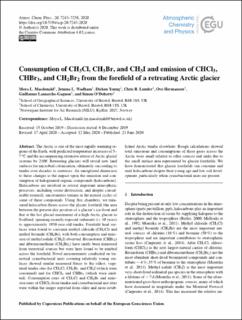| dc.contributor.author | Macdonald, Moya L. | |
| dc.contributor.author | Wadham, Jemma L. | |
| dc.contributor.author | Young, Dickon | |
| dc.contributor.author | Lunder, Chris Rene | |
| dc.contributor.author | Hermansen, Ove | |
| dc.contributor.author | Lamarche-Gagnon, Guillaume | |
| dc.contributor.author | O'Doherty, Simon | |
| dc.date.accessioned | 2020-08-04T07:34:03Z | |
| dc.date.available | 2020-08-04T07:34:03Z | |
| dc.date.created | 2020-08-03T14:47:32Z | |
| dc.date.issued | 2020 | |
| dc.identifier.citation | Atmospheric Chemistry and Physics. 2020, 20, 7243-7258. | en_US |
| dc.identifier.issn | 1680-7316 | |
| dc.identifier.uri | https://hdl.handle.net/11250/2670703 | |
| dc.description.abstract | The Arctic is one of the most rapidly warming regions of the Earth, with predicted temperature increases of 5–7 ∘C and the accompanying extensive retreat of Arctic glacial systems by 2100. Retreating glaciers will reveal new land surfaces for microbial colonisation, ultimately succeeding to tundra over decades to centuries. An unexplored dimension to these changes is the impact upon the emission and consumption of halogenated organic compounds (halocarbons). Halocarbons are involved in several important atmospheric processes, including ozone destruction, and despite considerable research, uncertainties remain in the natural cycles of some of these compounds. Using flux chambers, we measured halocarbon fluxes across the glacier forefield (the area between the present-day position of a glacier's ice-front and that at the last glacial maximum) of a high-Arctic glacier in Svalbard, spanning recently exposed sediments (<10 years) to approximately 1950-year-old tundra. Forefield land surfaces were found to consume methyl chloride (CH3Cl) and methyl bromide (CH3Br), with both consumption and emission of methyl iodide (CH3I) observed. Bromoform (CHBr3) and dibromomethane (CH2Br2) have rarely been measured from terrestrial sources but were here found to be emitted across the forefield. Novel measurements conducted on terrestrial cyanobacterial mats covering relatively young surfaces showed similar measured fluxes to the oldest, vegetated tundra sites for CH3Cl, CH3Br, and CH3I (which were consumed) and for CHCl3 and CHBr3 (which were emitted). Consumption rates of CH3Cl and CH3Br and emission rates of CHCl3 from tundra and cyanobacterial mat sites were within the ranges reported from older and more established Arctic tundra elsewhere. Rough calculations showed total emissions and consumptions of these gases across the Arctic were small relative to other sources and sinks due to the small surface area represented by glacier forefields. We have demonstrated that glacier forefields can consume and emit halocarbons despite their young age and low soil development, particularly when cyanobacterial mats are present. | en_US |
| dc.language.iso | eng | en_US |
| dc.rights | Navngivelse 4.0 Internasjonal | * |
| dc.rights.uri | http://creativecommons.org/licenses/by/4.0/deed.no | * |
| dc.title | Consumption of CH3Cl, CH3Br, and CH3I and emission of CHCl3, CHBr3, and CH2Br2 from the forefield of a retreating Arctic glacier | en_US |
| dc.type | Peer reviewed | en_US |
| dc.type | Journal article | en_US |
| dc.description.version | publishedVersion | en_US |
| dc.rights.holder | © Author(s) 2020. | en_US |
| dc.source.pagenumber | 7243-7258 | en_US |
| dc.source.volume | 20 | en_US |
| dc.source.journal | Atmospheric Chemistry and Physics | en_US |
| dc.identifier.doi | 10.5194/acp-20-7243-2020 | |
| dc.identifier.cristin | 1821382 | |
| cristin.ispublished | true | |
| cristin.fulltext | original | |
| cristin.qualitycode | 2 | |

